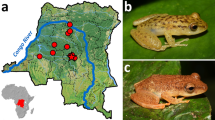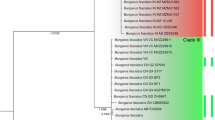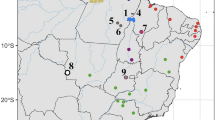Abstract
About 96% of the more than 4,800 living anuran species1 belong to the Neobatrachia or advanced frogs2,3,4. Because of the extremely poor representation of these animals in the Mesozoic fossil record, hypotheses on their early evolution have to rely largely on extant taxa5,6,7. Here we report the discovery of a burrowing frog from India that is noticeably distinct from known taxa in all anuran families. Phylogenetic analyses of 2.8 kilobases of mitochondrial and nuclear DNA unambiguously designate this frog as the sister taxon of Sooglossidae, a family exclusively occurring on two granitic islands of the Seychelles archipelago8. Furthermore, molecular clock analyses9 uncover the branch leading to both taxa as an ancient split in the crown-group Neobatrachia. Our discovery discloses a lineage that may have been more diverse on Indo-Madagascar in the Cretaceous period, but now only comprises four species on the Seychelles and a sole survivor in India. Because of its very distinct morphology and an inferred origin that is earlier than several neobatrachian families10, we recognize this frog as a new family.
This is a preview of subscription content, access via your institution
Access options
Subscribe to this journal
Receive 51 print issues and online access
$199.00 per year
only $3.90 per issue
Buy this article
- Purchase on Springer Link
- Instant access to full article PDF
Prices may be subject to local taxes which are calculated during checkout



Similar content being viewed by others
References
AmphibiaWeb [online] 〈http://amphibiaweb.org/〉 (Berkeley, California, 2003).
Frost, D. R. Amphibian Species of the World: an Online Reference V2.21 〈http://research.amnh.org/herpetology/amphibia/index.html〉 (American Museum of Natural History, 15 July 2002).
Ford, L. S. & Cannatella, D. C. The major clades of frogs. Herpetol. Monogr. 7, 94–117 (1993)
Duellman, W. E. & Trueb, L. Biology of Amphibians 1–670 (John Hopkins Univ. Press, Baltimore/London, 1986)
Hay, J. M., Ruvinsky, I., Hedges, S. B. & Maxson, L. R. Phylogenetic relationships of amphibian families inferred from DNA sequences of mitochondrial 12S and 16S ribosomal RNA genes. Mol. Biol. Evol. 12, 928–937 (1995)
Ruvinsky, I. & Maxson, L. R. Phylogenetic relationships among bufonoid frogs (Anura: Neobatrachia) inferred from mitochondrial DNA sequences. Mol. Phylogenet. Evol. 5, 533–547 (1996)
Feller, A. E. & Hedges, S. B. Molecular evidence for the early history of living amphibians. Mol. Phylogenet. Evol. 9, 509–516 (1998)
Nussbaum, R. A. Phylogenetic implications of amplectic behavior in sooglossid frogs. Herpetologica 36, 1–5 (1980)
Thorne, J. L. & Kishino, H. Divergence time and evolutionary rate estimation with multilocus data. Syst. Biol. 51, 689–702 (2002)
Avise, J. C. & Johns, G. C. Proposal for a standardized temporal scheme of biological classification for extant species. Proc. Natl Acad. Sci. USA 96, 7358–7363 (1999)
Savage, J. M. in Evolutionary Biology of the Anurans: Contemporary Research on Major Problems (ed. Vial, J. L.) 351–445 (Univ. Missouri Press, Columbia, 1973)
Coffin, M. F. & Rabinowitz, P. D. in Geology and Geophysics of Continental Margins (eds Watkins, J. S., Zhiqiang, F. & McMillen, K. J.) 207–246 (American Association of Petroleum Geologists, Tulsa, Oklahoma, 1992)
Tyler, M. J. Phylogenetic significance of the superficial mandibular musculature and vocal sac structure of sooglossid frogs. Herpetologica 41, 173–176 (1985)
Hay, W. W. et al. in Evolution of the Cretaceous Ocean-Climate System (eds Barrera, E. & Johnson, C.) 1–48 (Geological Society of America, Boulder, 1999)
Wilkinson, M., Sheps, J. A., Oommen, O. V. & Cohen, B. L. Phylogenetic relationships of Indian caecilians (Amphibia: Gymnophiona) inferred from mitochondrial rRNA gene sequences. Mol. Phylogenet. Evol. 23, 401–407 (2002)
Bossuyt, F. & Milinkovitch, M. C. Amphibians as indicators of Early Tertiary ‘Out-of-India’ dispersal of vertebrates. Science 292, 92–95 (2001)
Spinar, Z. V. & Hodrova, M. New knowledge of the genus Indobatrachus (Anura) from the Lower Eocene of India. Amphib. Reptil. 6, 363–376 (1985)
Lynch, J. D. Evolutionary Relationships, Osteology and Zoogeography of Leptodactyloid Frogs 1–238 (Univ. Kansas, Museum of Nat. Hist. Misc. Publ. 53, Lawrence, 1971)
Nussbaum, R. A. Mitotic chromosomes of Sooglossidae (Amphibia: Anura). Caryologia 32, 279–298 (1979)
Krause, D. W., Prasad, G. V. R., von Koenigswald, W., Sahni, A. & Grine, F. E. Cosmopolitanism among Gondwanan Late Cretaceous mammals. Nature 390, 504–507 (1997)
Krause, D. W. Fossil molar from a Madagascan marsupial. Nature 412, 497–498 (2001)
Bossuyt, F. & Milinkovitch, M. C. Convergent adaptive radiations in Madagascan and Asian ranid frogs reveal covariation between larval and adult traits. Proc. Natl Acad. Sci. USA 97, 6585–6590 (2000)
Swofford, D. L. PAUP*: Phylogenetic Analysis Using Parsimony (* and other methods) Version 4.0b10 (Sinauer Associates, Sunderland, Massachusetts, 2002)
Posada, D. & Crandall, K. A. MODELTEST: testing the model of DNA substitution. Bioinformatics 14, 817–818 (1998)
Lemmon, A. R. & Milinkovitch, M. C. The Metapopulation genetic algorithm: an efficient solution for the problem of large phylogeny estimation. Proc. Natl Acad. Sci. USA 99, 10516–10521 (2002)
Huelsenbeck, J. P. & Ronquist, F. MRBAYES: Bayesian inference of phylogenetic trees. Bioinformatics 17, 754–755 (2001)
Ruta, M., Coates, M. I. & Quicke, D. L. J. Early tetrapod relationships revisited. Biol. Rev. 78, 251–345 (2003)
Benton, M. J. Vertebrate Palaeontology 2nd edn, 1–452 (Chapman & Hall, London, 1997)
Gao, K. & Shubin, N. H. Earliest known crown-group salamanders. Nature 422, 424–428 (2003)
Acknowledgements
We are grateful to the Kerala Forest Department for collecting permits (to S.D.B.), and to J. Nagaraju (Molecular Genetics Laboratory, CDFD, Hyderabad) for support in sequencing Nasikabatrachus. P. Mardulyn, M. C. Milinkovitch and K. Roelants provided comments on an earlier draft. D. Cannatella, R. Brown, S. Donnellan, R. Drewes, J. Vindum, R. Nussbaum, M. Vences, E. Scott and D. Wake provided tissue samples. A. Mannaert assisted in the molecular work. D. Adriaens, S. Devaere, F. Verschoten and A. Herrel were supportive in osteological analyses. J. Thorne made his software available. M. Coates provided suggestions for calibration.
Author information
Authors and Affiliations
Corresponding author
Ethics declarations
Competing interests
The authors declare that they have no competing financial interests.
Supplementary information
41586_2003_BFnature02019_MOESM1_ESM.pdf
Supplementary Information: This file contains measurements on the holotype, notes on amplexus, discussion on convergence, list of species included in the phylogenetic analyses, uncorrected ("p") distance matrix for mt- and nuDNA, Bayesian analyses of individual genes, and divergence time estimates. (PDF 861 kb)
Rights and permissions
About this article
Cite this article
Biju, S., Bossuyt, F. New frog family from India reveals an ancient biogeographical link with the Seychelles. Nature 425, 711–714 (2003). https://doi.org/10.1038/nature02019
Received:
Accepted:
Issue Date:
DOI: https://doi.org/10.1038/nature02019
This article is cited by
-
Population genetic structure and evolutionary demographic patterns of Phrynoderma karaavali, an edible frog species of Kerala, India
Journal of Genetics (2022)
-
DNA barcode and phylogenetic analysis of dung beetles (Coleoptera: Scarabaeidae) from the Western Ghats biodiversity hotspot, India
International Journal of Tropical Insect Science (2021)
-
Aenigmachannidae, a new family of snakehead fishes (Teleostei: Channoidei) from subterranean waters of South India
Scientific Reports (2020)
-
Assemblage and Diversity of Anurans in Two Forests of the Western Ghats
Proceedings of the Zoological Society (2020)
-
Evolutionary biogeography of the centipede genus Ethmostigmus from Peninsular India: testing an ancient vicariance hypothesis for Old World tropical diversity
BMC Evolutionary Biology (2019)
Comments
By submitting a comment you agree to abide by our Terms and Community Guidelines. If you find something abusive or that does not comply with our terms or guidelines please flag it as inappropriate.



